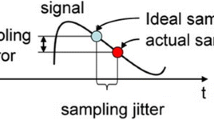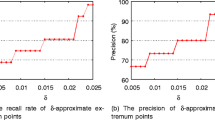Abstract
In wireless sensor networks (WSN), a query is commonly used for collecting periodical data from the objects under monitoring. Amount of sensory data drawn across WSNs by a query can significantly impact WSN’s power consumption and its lifetime, since WSNs are battery operated. We present a novel methodology to construct an optimal query containing fewer sensory attributes as compared to a standard query, thereby reducing the sensory traffic in WSN. Our methodology employees a statistical technique, principal component analysis on historical traces of sensory data to automatically identify important attributes among the correlated ones. The optimal query containing reduced set of sensory attributes, guarantees at least 25% reduction in energy consumption of WSN with respect to a standard query. Furthermore, from reduced set of data reported by optimal query, the methodology synthesizes complete set of sensory data at a base station (reporting unit with surplus power supply). We validated the effectiveness of our methodology with real world sensor data. The result shows that our methodology can synthesize complete set of sensory data analogues to standard query with 93% accuracy.











Similar content being viewed by others
Notes
The term mote was coined by researchers involved in ‘smartdust’ project at Berkeley.
References
Bajaber F, Awan I (2010) Energy efficient clustering protocol to enhance lifetime of wireless sensor network. J Ambient Intell Human Comput 1(4):239–248
Beyer K, Goldstein J, Ramakrishnan R, and Shaft U (1999) When is “nearest neighbor” meaningful? Lecture notes in computer science, vol 1540, pp 217–235
Bonnet P, Gehrke J, and Seshadri P (2001) Towards sensor database systems. In: Proceedings of the 2nd international conference on mobile data management, vol 43, pp 551–558
Box MJ, Box RM (1996) Computation of the variance ratio distribution. Comput J 12(3):277–278
Bronnimann H, Chen B, Dash M, Haas P, Scheuermann P (2003) Efficient data reduction with EASE. In: Proceedings of the 9th ACM international conference on knowledge discovery and data mining, pp 59–68
Chen M, Fowler ML (2004) Data compression trade-offs in sensor networks. In: Proceedings of mathematics of data/image coding, compression, and encryption VII, with applications, vol 5561, pp 96–107
Deshpande A, Guestrin C, Madden S, Hellerstein J, Hong W (2004) Model-driven data acquisition in sensor networks. In: Proceedings of the 13th international conference on very large databases, vol 3, pp 588–599
DIM Project (2007) DIN for sensor networks. http://enl.usc.edu/projects/dim/index.html. Accessed 7 May 2007
Heinzelman WR, Chandrakasan A, Balakrishnan H (2000) Energy-efficient communication protocol for wireless micro sensor networks. In: Proceedings of the 33rd Hawaii international conference on system sciences, 4–7 Jan 2000, vol 2
Hiyama M, Ikeda M, Barolli L, Takizawa M (2010) Performance analysis of multi-hop ad-hoc network using multi-flow traffic for indoor scenarios. J Ambient Intell Human Comput 1(4):283–293
Jolliffe IT (2002) Principal component analysis, 2nd edn. Springer, New York
Ju H, Cui L (2005) EasiPC: a packet compression mechanism for embedded WSN. In: Proceedings of the 11th IEEE international conference on embedded and real-time computing systems and applications, pp 394–399
Kaiser F (1974) Factorial simplicity index and transformation. Psychometrika 49(2):277–295
Le S, Julie J, Francois H (2008) FactoMine: an R package for multivariate analysis. J Stat Softw 25(1):1–18
Liu X, Ma Z, Cao X, Liu S (2010) A query processing method in multi-user scenarios. In: proceedings of 5th international ICST conference on communication and networking, pp 25–33
Madden S, Franklin MJ (2002) Fjording the stream: architecture for queries over streaming sensor data. In: Proceedings of the 18th international conference on data engineering, p 555
Madden S, Hellerstein JM (2002) Distributing queries over low-power wireless sensor networks. In: Proceedings of the 2002 ACM SIGMOD international conference on management of data, 2–6 Jan 2002
Naoto K, Shahram L (2005) A survey on data compression in wireless sensor networks. In: Proceedings of the international conference on information technology: coding and computing, vol 02, pp 8–13
Nose Y, Kanzaki A, Hara T, Nishio S (2010) A route construction based on measured characteristics of radio propagation in wireless sensor networks. J Ambient Intell Human Comput 1(4):259–270
Ozsy MT, Valduriez P (1991) Principles of distributed database systems. Prentice Hall, Englewood Cliffs
Raghunathan V, Schurgers C, Park S, Srivastava MB (2002) Energy-aware wireless microsensor networks. IEEE Signal Process Mag 19(2):40–50
Rakesh A, Ramakrishnan S (1994) Fast algorithms for mining association rules in large databases. In: Proceedings of the 20th international conference on very large databases, pp 487–499
Shakshuki E, Malik H, Denko M (2008) Software agent-based directed diffusion in wireless sensor network. J Telecommun Syst 38(4):161–174
Shatdal A, Naughton JF (1995) Adaptive parallel aggregation algorithms. In: Proceedings of the 1995 ACM SIGMOD international conference on Management of data, pp 104–114
Silberstein A, Braynard R, Ellis C, Munagala K (2006) A sampling-based approach to optimizing top-k queries in sensor networks. In: Proceedings of the 22nd international conference on data engineering, p 68
Tik LB, Khuan CT, Palaniappan S (2009) Monitoring of an aeroponic greenhouse with a sensor network. Int J Comput Sci Netw Secur 9(3):240–246
Uchida N, Takahata K, Shibata Y (2010) Transmission control methods with multihopped environments in cognitive wireless networks. J Ambient Intell Human Comput 1(4):249–257
Wu M, Xu J, Tang X, Lee C (2007) Top-k monitoring in wireless sensor networks. IEEE Trans Knowl Data Eng 19(7):962–976
Xu R, Li Z, Wang C, Ni P (2003) Impact of data compression on energy consumption of wireless-networked handheld devices. In: Proceedings of 23rd international conference on distributed computing systems, pp 302–311
Yazti Z, Vagena Z, Gunopulos D, Kalogeraki V, Tsotras V (2005) The threshold join algorithm for top-k queries in distributed sensor networks. In: Proceedings of the 2nd international workshop on data management for sensor networks, pp 61–66
Yeo M, Seong D, Yoo J (2009) Data-aware top-k monitoring in wireless sensor networks. In: Radio and wireless symposium, 18–22 Jan 2009, pp 103–106
Yu CT, Chang CC (2000) The state of the art in distributed query processing. ACM Comput Surv 16(4):399–433
Zhang Y, Hull B, Balakrishnan H, Madden S (2007) ICEDB: intermittently connected continuous query processing. In: Proceedings of international conference on data engineering
Author information
Authors and Affiliations
Corresponding author
Rights and permissions
About this article
Cite this article
Malik, H., Malik, A.S. & Roy, C.K. A methodology to optimize query in wireless sensor networks using historical data. J Ambient Intell Human Comput 2, 227–238 (2011). https://doi.org/10.1007/s12652-011-0059-x
Received:
Accepted:
Published:
Issue Date:
DOI: https://doi.org/10.1007/s12652-011-0059-x




